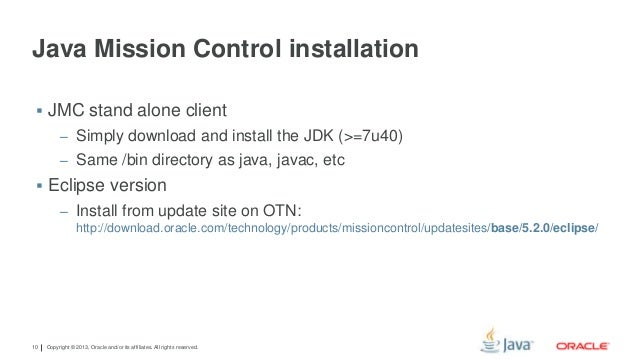
Java Mission Control Download
Starting with Java 7 Update 40, you can find the Java Control Panel through the Windows Start menu. Right-click on the Start button and select the Control Panel option. In the Windows Control Panel, click on Programs. Click on the Java icon to open the Java Control Panel. Drag the Mouse pointer to the bottom-right corner of the screen, then. 1 About Java Mission Control 2 Using the Java Mission Control Client. 2.1 Starting the Java Mission Control Client; 2.2 Java Mission Control Client GUI. 2.2.1 Tabs and Tab Groups; 2.2.2 Panels; 3 Accessibility in Java Mission Control. 3.1 Screen Readers; 3.2 Java Mission Control Accessibility Mode; 3.3 Showing Text Labels on Buttons; 3.4.
-->Zulu Mission Control is a fully-tested build of JDK Mission Control, which was open-sourced by Oracle in 2018 and is managed as a project under the OpenJDK umbrella. Coupled with Java Flight Recorder (JFR), Mission Control delivers low-overhead, interactive monitoring and management capabilities for Java workloads.
Zulu Mission Control is compatible with the following Java Development Kits (JDKs) and Java Runtime Environments (JREs):
- Zulu 12.1 and later
- Zulu 11.0 and later
- Zulu 8u202 (8.36) and later
- Oracle OpenJDK 11 and 15 and later
- Oracle Java 11.0 and later
- Oracle Java 8.0 and later
Install Zulu Mission Control and connect to a JVM
To install Zulu Mission Control, connect to a Java Virtual Machine (JVM), and gain real-time visibility into all aspects of a running application, do the following:
Install a Zulu Mission Control-compatible JDK and JRE.
Download Zulu Mission Control, choose the appropriate version for your system, save it locally, and change to that directory.
Expand the downloaded file.
Linux:
Windows:
macOS:
Start your Java application by using one of the compatible JDKs. For example:
Start Zulu Mission Control.
Linux:
Windows:
macOS:
(Optional) Switch the JVM installation for Mission Control.
On Windows devices, zmc.exe uses the default JVM installation that's configured in the registry. Zulu Mission Control must be launched from a full JDK to be able to detect local JVM instances automatically. If the installation is a JRE, no JVM will be detected, and you will receive the following warning:
To change the JVM that's used by Mission Control, do the following:
a. Open the zmc.ini configuration file, which is in the same directory as the zmc.exe file.
b. Before the line
-vmargs, add two lines:- On the first line, enter
–vm. - On the second line, enter the path to your JDK installation (for example,
C:Program FilesJavajdk1.8.0_212binjavaw.exe).
- On the first line, enter
Locate the JVM that's running your application by doing the following:
a. In the left pane of the Zulu Mission Control window, select the JVM Browser tab.
b. In the list, select and expand the JVM instance that's running your application.
Start a flight recording, if necessary. Wii homebrew game downloads.
a. In the left pane, under Flight Recorder, if a No Recordings message is displayed, start a recording by right-clicking Flight Recorder and then selecting Start Flight Recording.
b. Select either Time fixed recording or Continuous recording, and either a Profiling configuration (fine-grained) or a Continuous configuration (lower overhead), and then select Finish.
A flight recording should appear below the Flight Recorder line in the JVM browser.
Dump the flight recording. To do so, right-click the line that represents the flight recording, and then select Dump whole recording.
A new tab appears in the large pane on the right side of the Zulu Mission Control window. This pane represents the flight recording that was just dumped from the JVM that's running your application.
Ras g and the afrikan space program. Examine the flight recording by using Zulu Mission Control. To do so, select the Outline tab in the left pane of the Zulu Mission Control window. This tab displays various views of the data that's collected in the flight recording.
Resources
To learn more, go to the Azul Systems site and view Azul Webinar: Open Source Flight Recorder and Mission Control - Managing and Measuring OpenJDK 8 Performance. The video is narrated by Azul Systems Deputy CTO Simon Ritter. The Flight Recorder discussion starts at 31:30.
Production time profiling and diagnostics for OpenJDK JDK Mission Control, OpenJDK & Java Community,Written in,+ (dual)WebsiteJDK Mission Control is an open source tools suite for the. The tools help finding problems in, and optimizing, programs running on the in production. JDK Mission Control supports OpenJDK 11 (and above) and Oracle JDK 7u40 (and above).JDK Mission Control primarily consists of the following tools:. A JFR analyzer and visualizer. A ConsoleThere are also various plug-ins available, such as:.
A heap dump (hprof format) analyzer (JOverflow). Contents.History JDK Mission Control started out as JRockit Mission Control, a production time profiling and diagnostics tools suite which was delivered as a part of the JRockit JVM distribution. After Oracle acquired Sun Microsystems, JRockit Flight Recorder and JRockit Mission Control were rebranded Java Flight Recorder and Java Mission Control. In 2018 both Java Flight Recorder and Java Mission Control were open sourced.
When open sourced they were rebranded JDK Mission Control and JDK Flight Recorder respectively, due to Java trademark issues. At the same time, the delivery format for JMC was changed, making it easier to upgrade JMC and the JDK independently. See also.